The digestive system
1/98
There's no tags or description
Looks like no tags are added yet.
Name | Mastery | Learn | Test | Matching | Spaced |
|---|
No study sessions yet.
99 Terms
What are the functions of the digestive system?
Ingestion, secretion, digestion, absorption, elimination
What is ingestion?
Taking food into the system
What is secretion?
Enzymes, hormones, bile, and HCl are released into the digestive tract to assist in digestion
What is digestion?
Breaking large biomolecules into small organic molecules
What is absorbtion?
Taking the digested nutrients into the body (blood stream)
What is elimination?
Getting rid of the indigestible wastes
What is anatomy?
The study of structures
What is physiology?
The study of functions
What are the two main processes of digestion that occur simultaneously?
Mechanical digestion and chemical digestion
What is mechanical digestion?
The physical breakdown of food
What is an example of mechanical digestion?
Chewing or churning
What is the purpose of mechanical digestion?
Increases surface area of food, which increases. efficiency of chemical digestion
What is chemical digestion?
The chemical breakdown of food
What is an example of chemical digestion?
Digestive enzymes
What are carbohydrates broken into?
Monosaccharides (ie. glucose)
What are lipids broken into?
Triglycerides (glycerol and fatty acids)
What are proteins broken into?
Amino acids
What are nucleic acids broken into?
Nucleotides
What are the layers of the digestive tract?
Mucosa, submucosa, muscularis, serosa
What is the musocsa layer of the digestive tract?
The inner layer, next to the food, containing two major types of epithelial cells
What are the two epithelial cells in the mucosa layer?
Gladular cells and globulet cells
What do glandular cells do?
Produce enzymes and chemicals
What do goblet cells do?
Produce mucus
What is the submusoca layer of the digestive tract?
Contains many blood and lymph vessels to transport absorbed nutrients
What is the muscularis layer of the digestive tract?
Two muscular layers
What is the muscularis layer of the digestive tract responsible for?
Peristalisis
What is the serosa layer of the digestive tract?
Outermost protective layer that secretes a lubricating fluid to remove friction with other organs
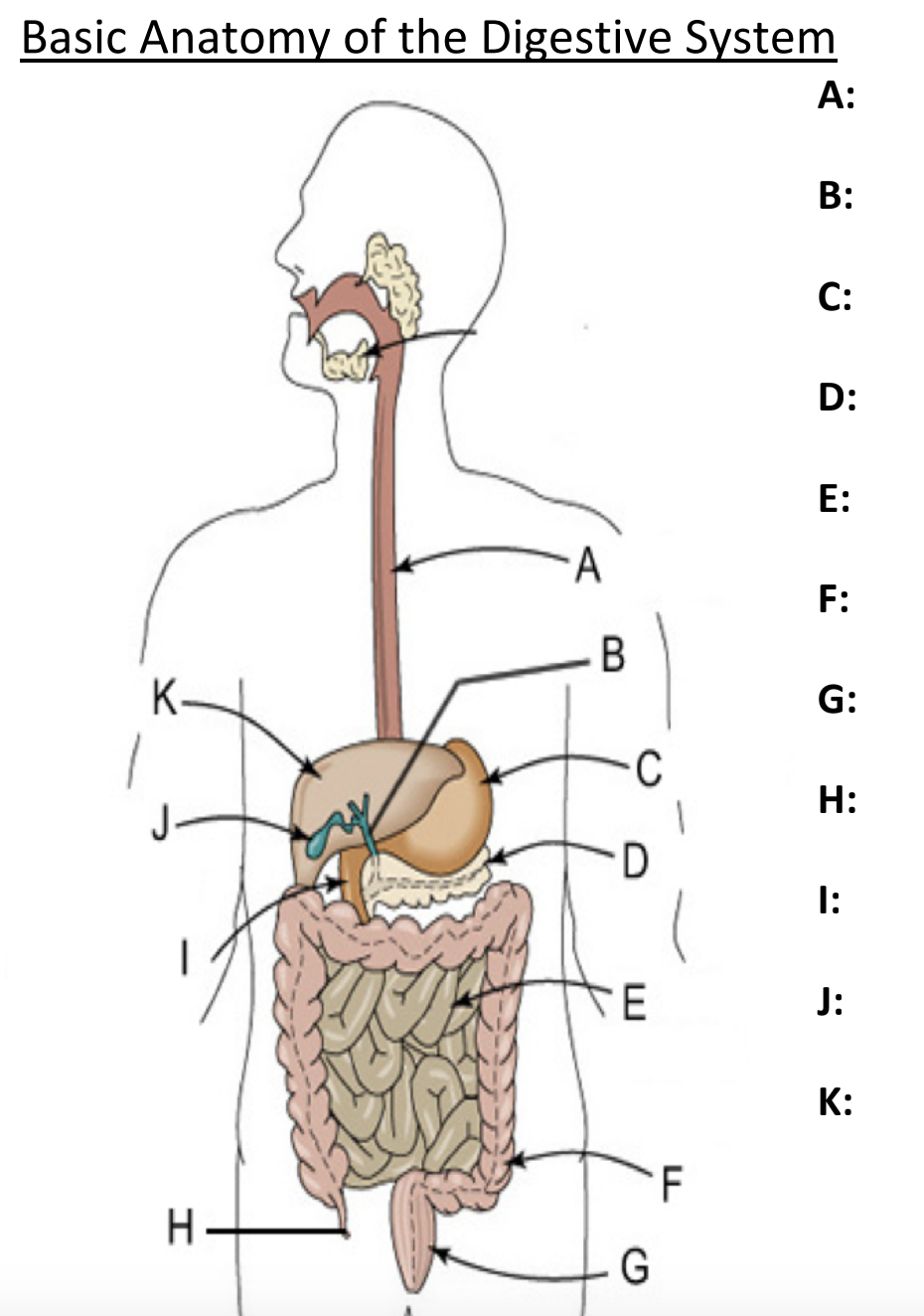
Label this image
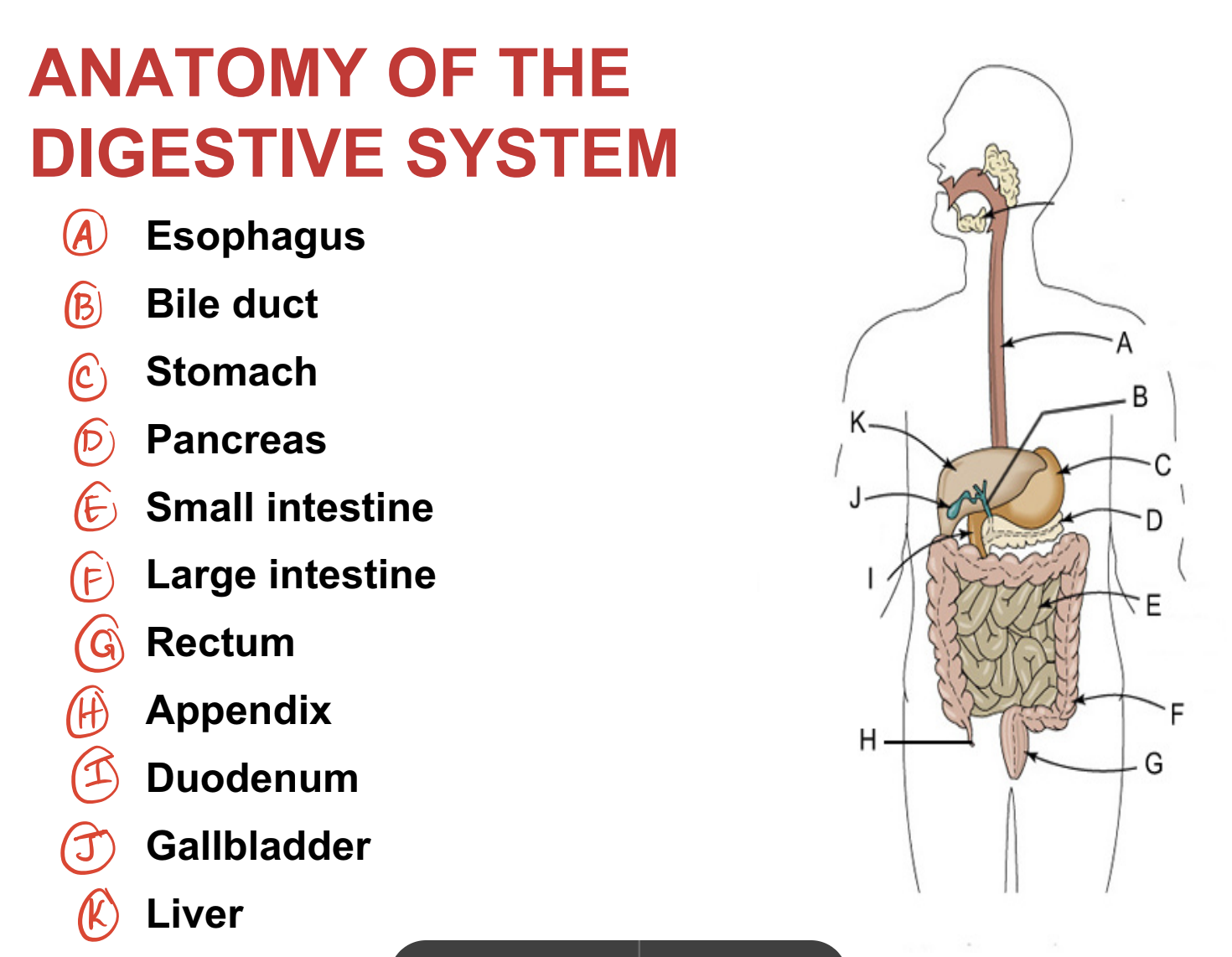
Which organs are part of the main tract?
Esophagus, stomach, small intestine, large intestine, rectum, duodenum
What organs are accessory organs?
Bile duct, pancreas, gall bladder, liver, salivary glands
What is a main tract organ?
An organ which food moves through it on its journey through the body
What is an accessory organ?
An organ that aids in digestion but the food does not move through it
What are the functions of the mouth?
Ingestion and to begin digestion
What are the parts of the mouth?
Teeth, tongue, pharynx
What do the teeth do?
Take in the food and begin mechanical digestion by breaking down the food into smaller pieces
What are the salivary glands?
Ducted glands that produce saliva
What do the salivary glands do?
Liquifies food, contains salivary amylase and begins chemical digestion, and lubricates and softens the bolus of food
What is the bolus of food?
Small mass of partially digested food
What does the equation with salivary amylase look like?
Starch is the substrate, salivary amylase is the enzyme, maltose is a disaccharide and product

What are the functions of the tongue?
Contains taste buds
Moves the food around in the mouth to mix the food and saliva
Pushes the bolus of food to the back of the throat to the swallow reflux centre
What do taste buds do and where are they located?
They are sensory receptors which are located at the back of the tongue, which helps to protect us against poisons (poisons most often taste bitter)
What is the pharynx?
The back of the throat, which opens to both the respiratory and digestive systems
What happens when food is placed on the swallowing reflex centre?
The soft palate covers the opening to the nose
The epiglottis covers the trachea
Peristalsis of the esophagus begins
What is the esophagus?
A 30 cm long tube that connects the pharynx to the stomach
What is special about the esophagus?
It is the only part of the digestive system where no digestion occurs
What is located at the beginning to the stomach?
A ring of muscle called the cardiac sphincter
What does the cardiac sphincter do?
Ensures that no food reenters the esophagus
What happens when someone has a dilated or weak cardiac sphincter?
Allows for acid reflux or heartburn to occur
How does food move through the digestive system?
By a process called peristalsis
What is peristalsis?
A slow, rhythmic contraction that pushes the bolus along
What is the stomach?
A J shaped organ that can hold 3-4 litres of food
What does the stomach do?
Churns food and liquifies it (mechanical digestion)
Begins the chemical digestion of proteins
What aids mechanical digestion in the stomach?
Aided by the ridges in the mucosa layer of the stomach called rugae
What are the three types of cells in the stomach?
Chief cells, parietal cells, mucoid cells
What do chief cells do?
Produce an inactive enzyme called pepsinogen
What do perietal cells do?
Produce hydrochloric acid (HCl)
What do mucoid cells do?
Form the inner lining of the stomach and produce mucus to protect the stomach from the HCl
What happens if the stomach is damaged by the acidic pH
A stomach ulcer is created
What is a stomach ulcer?
An open sore in the wall of the stomach caused by a gradual breakdown of the tissue
How are most stomach ulcers initiated?
By infection of the stomach by a bacterium called heliobacter pylori, which can impair the ability of the mucoid cells to produce protective mucus
What does treatment of stomach ulcers look like?
Antibiotics
What do the steps of going from pepsinogen to pepsin look like?
Pepsinogen is inactive, HCl (pH 2-3) activates it, proteins are substrate, pepsin is enzyme, peptide and polypeptides (which aren’t fully broken down) are products
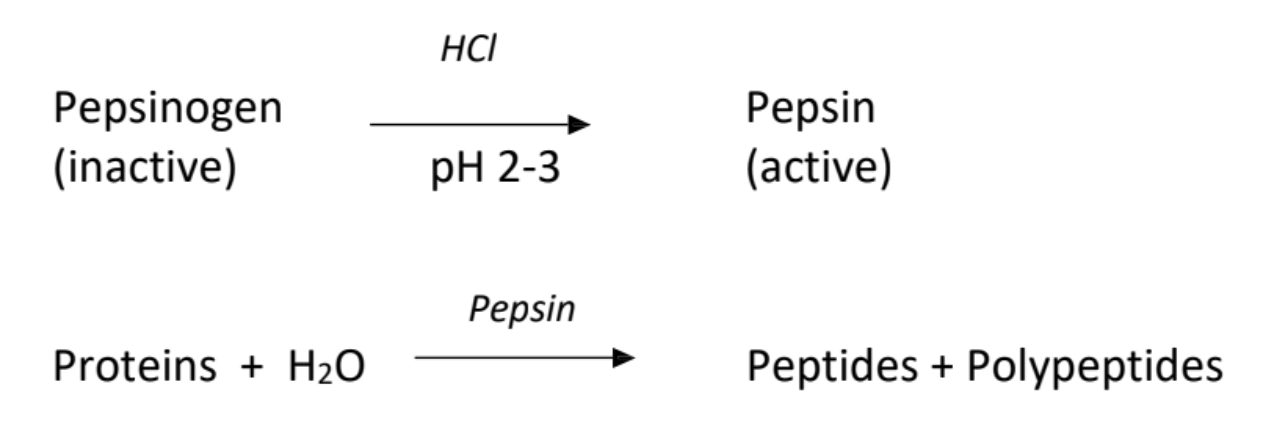
When is hydrochloric acid (HCl) released?
When proteins enter the stomach
What is initiated when proteins enter the stomach?
Pepsinogen is transformed into the active enzyme pepsin, which begins the digestion of the proteins into peptides and polypeptides
How long does it take for the stomach to fully empty?
24 hours
What is the liquid that leaves the stomach called?
Chyme
Where is the pyloric sphincter?
At the base of the stomach
What does the pyloric sphincter do?
Releases chyme into the small intestine at a slow, controlled rate
What does the small intestine do?
Completes digestion and begins absorption of nutrients
What are the three regions of the small intestine?
Duodenum, jejunum, ileum
What does the duodenum do?
Completes chemical digestion
What does the jejunum do?
Finished digestion and begins absorbtion
What is the ileum and what does it do?
It is the longest section and its function is to absorb all the nutrients into the circulatory and lymphatic systems
Why does the small intestine have an increased rate of absorption (a quick diffusion rate)?
Due to its highly convoluted/folded walls that increase surface area
What are villi?
Folds in the mucosa layer of the small intestine
What are microvilli?
Villi cells have even more smaller folds on them called microvilli
What do villi and microvilli do?
Increase the surface area of absorption
Where does the absorption of nutrients take place?
Through the columnar (epithelial) cells microvilli
What does the absorption of nutrients require?
Energy, since it is active transport
What are sugars, amino acids, and nucleotides absorbed by?
Capillaries (blood stream)
What are glycerol and fatty acids absorbed by?
Lymph lacteals (lymph capillaries)
How are the blood vessels and lymph lacteals connected?
The blood vessels are wrapped around the lymph lacteals
How do the walls of the duodenum assist in digestion?
The glands of the submucosa and the columnar (epithelial) cells of the mucosa produce and release a variety of enzymes
What does the equation for peptidases look like?

What does the equation for nucleosides and phosphatase look like?

What does the equation for maltase look like?

What does the equation for sucrase and lactase look like?
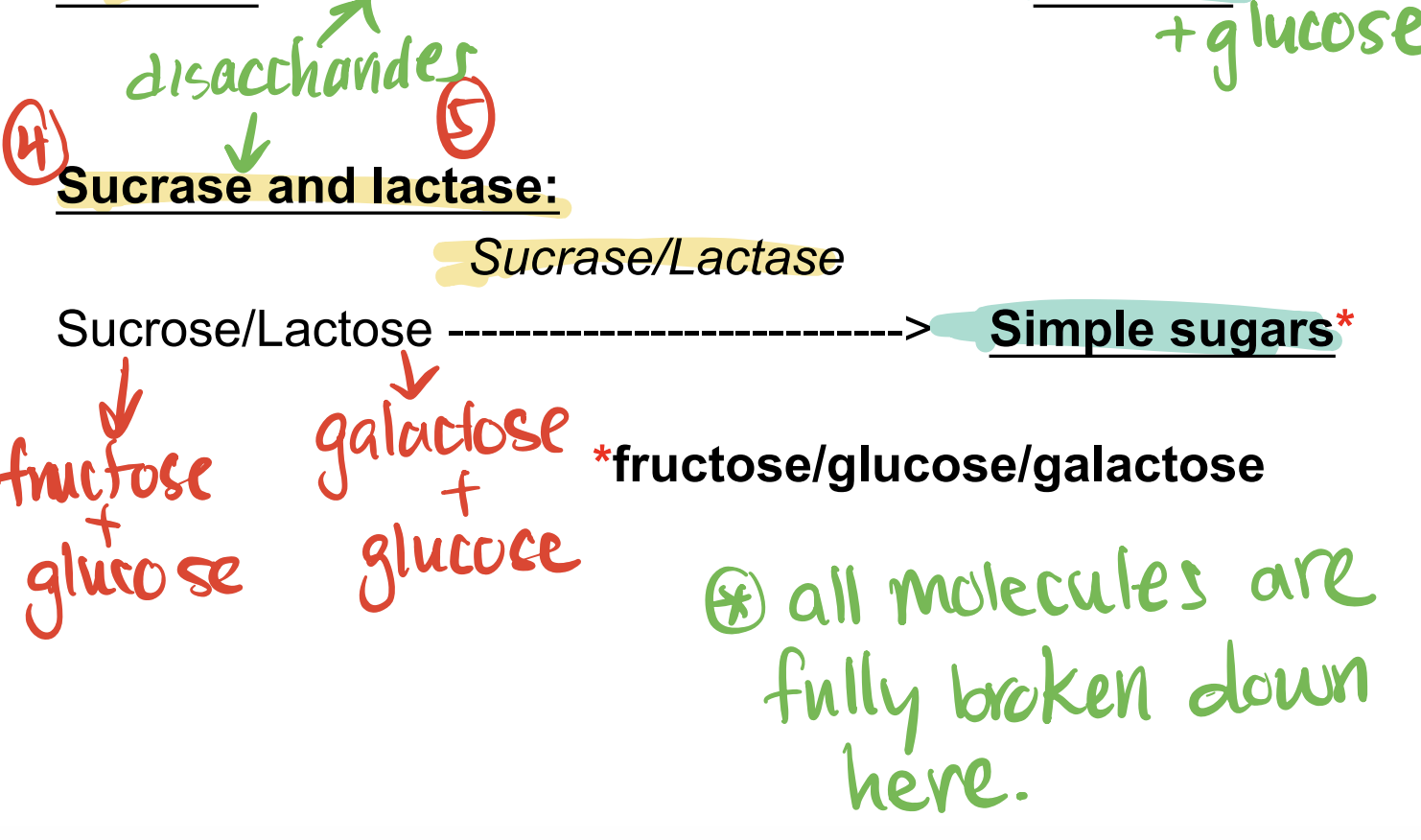
At what point in the digestive system are molecules fully broken down?
By the end of the small intestine
Why is the large intestine called large?
It is large in diameter, but much shorter in length than the small intestine
What are the parts of the large intestine?
Ascending colon, transverse colon, descending colon, sigmoid colon, rectum, and cecum
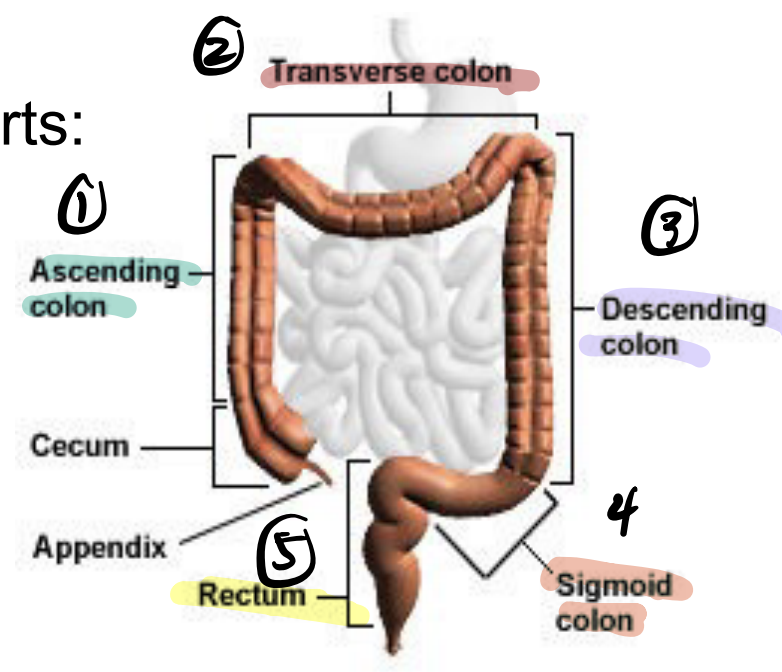
What is the cecum?
A small pouch that takes the food from the small intestine to the large intestine
What does the large intestine do?
It is an absorbitor of the water and salts that were used in the digestive process
What do the microbes (bacteria and fungi) that live in the large intestine do?
Slow movement of waste through the colon, which allows time for water to be reabsorbed
Eat the wastes and produce useful things that we need to survive (vitamins, amino acids, growth factors)
Produce waste of their own (methane gas)
What happens by the end of the large intestine?
Wastes are transformed into feces
What happens if waste moves through the large intestine too quick?
It cannot absorb enough water and you have diarrhea (liquid stool)
What happens if waste moves through the large intestine too slow?
It will absorb too much water and you will have constipation (solid stool)
What is Crohn’s disease?
A persistent inflammation of the intestine that results in recurrent episodes of abdominal cramping (which may be severe) and bloody diarrhea
It is an autoimmune disorder that causes a person’s immune system to mistakenly attack its own intestinal tissue (or attack the normal good bacteria that lives in the gut)
What causes Crohn’s disease?
Genetic predisposition is a factor, as are several environmental triggers, such as smoking and diet
How long does the entire process of digestion take from mouth to anus?
24 hours